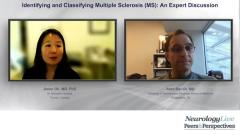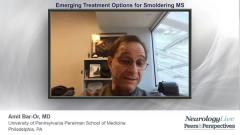
Smouldering Multiple Sclerosis Introduction
Experts begin this series on smouldering multiple sclerosis (MS) highlighting our current understanding of pathophysiology, it’s prevalence, and how we may better detect it in the future.
Episodes in this series

Transcript
Jiwon Oh, MD, PhD: Hello and thank you for joining this Neurology Live Peers and Perspectives presentation titled “Expert Perspectives on the Management of Smouldering MS.” I'm Jiwon Oh, MD, PhD, and I'm the medical director of the Barlo MS Program at St Michael's Hospital at the University of Toronto. I'm delighted to be joined by Dr Amit Bar-Or, MD, who is the Melissa and Paul Anderson President's Distinguished Professor and chief of the MS division at the University of Pennsylvania Perelman School of Medicine. Welcome, Dr Bar-Or.
Amit Bar-Or, MD: Thanks, Jiwon. Great to be here.
Jiwon Oh, MD, PhD: Today we're going to discuss ongoing research efforts and evolving understandings related to smouldering MS and how these may shape new approaches to treatment. So, let's begin. So, I'll just start by, Amit, asking you a number of more clinically oriented questions, talking about a concept that seems to be kind of the topic du jour at almost every single MS congress we've been to in the last number of years. But smouldering MS is something that everybody is talking about. Can you just give us a general overview on what people mean when they're talking about smouldering MS and how does this differ from more traditional concepts of different MS subtypes and pathological mechanisms underlying the disease?
Amit Bar-Or, MD: Sure. The smouldering aspect of MS is really this lower-level background, gradual ongoing worsening, that patients may experience clinically but reflects one or more biological processes that we think are probably taking place sub-clinically, meaning without the patient necessarily being aware, or it being obvious on exam. And this is something that reflects the 2 different processes biologically that create injury in the central nervous system [CNS] of patients with multiple sclerosis. One, of course, is the relapse biology and that, we think, involves immune cells getting activated outside of the CNS and trafficking in and creating these focal inflammatory lesions. The relapses clinically are evident in a subset of these. There are many more biological events, if you like, that happen under the surface. But beyond that, and particularly evident when we're able to control relapses very well, when, for instance, high efficacy therapies, is that many, if not most patients, may experience some gradual worsening in different domains and that creep, if you like, of ongoing worsening is now thought to reflect a more smouldering biological process or processes that we'll talk about a little bit more later. And that's really where people have focused a lot of attention on this aspect of multiple sclerosis.
Jiwon Oh, MD, PhD: And how prevalent would you say smouldering MS is? Just because I think it's really interesting that I think it's something that we recognize exists for a while, yet right now there seems to be such a huge focus on it. And so maybe you can comment on how prevalent you think smouldering MS is and why now there is such a focus on this concept.
Amit Bar-Or, MD: Sure, well, it's probably very prevalent. In fact, most, if not all patients probably have the process happening, whether evident or not. And historically, Jiwon, we have described MS based on the clinical appearance of…people having initially relapses and remissions. And then we said that many of them may end up progressing without the relapses. And we call that secondary progressive MS with the idea that relapsing remitting transitions into secondary progressive MS. Separately, in about 10 to 15% of patients rather than having relapses at the onset, they seem to just get worse gradually from the onset, and we've referred to that as primary progressive MS. And many people thought over the years that these are 2 perhaps different faces of the same disease, and people have either this or that. We now believe that these 2 processes are occurring with a great deal of overlap, and they probably coexist in the great majority of people over decades of their MS. Many more relapses occur under the surface than we appreciate, and much more of this progressive smouldering process occurs under the surface than we appreciate. And it's the recognition on one hand that we've had for quite a while that progressive MS is a major unmet need, but not yet having treatments that meaningfully impact it, and now generations of treatment that we hope will finally impact this aspect of MS, as well as the ability to start seeing some of this aspect of the MS process through research imaging approaches.
Jiwon Oh, MD, PhD: And, so, why now, though? Why do you think that we're focusing so much on smouldering MS now? Because, as you said, I think we've known for some time that it exists. It's just that it seems like there is such a focus on smouldering MS. I mean, do you think this is related to the fact that we're using higher efficacy treatments? Are we identifying it more clearly clinically?
Amit Bar-Or, MD: Well, I think that we are probably doing a somewhat better job identifying it clinically, although I think that we still have a ways to go there. I think that much of this is actually sort of stewarded or pushed along by therapeutic developments. The prospect of generations of treatment that we think may impact the biologies, not just of relapsing MS, but also the smouldering MS. We have, I think, changed our view of MS over the years with the development of multiple therapies and particularly the therapies that have a high efficacy against relapses. The bar is set much higher, and our goal is to stop any relapse in all patients, but we recognize that even when we successfully do that, people are continuing to progress, and we think that that's sort of a reflection of the smouldering process, so it remains the current major unmet need in parallel to developing therapies that we hope for the first time will meaningfully target that unmet need.
Jiwon Oh, MD, PhD: I'm just going to follow up on one more thing that you mentioned. You described our current classification of MS disease subtypes. Do you think it's time, given that the field is recognizing that smouldering MS is highly prevalent, and as you said, likely present from the very earliest stages of the disease, do you think it's time that we revisit how we classify MS?
Amit Bar-Or, MD: I do, and I think that there's a movement to try to classify MS biologically, very much because this sort of invites the treatment of choice or the combination of treatments. So, we have always, as clinicians, been proud of our ability to diagnose, and I think that that's something that's shared across the neurology community. And in the past, we've sometimes said, well, we treat the condition, we don't treat the imaging of the condition, but we've learned over the years that paying attention to the imaging is actually incredibly important because, as good as we may be as clinicians, much of MS, most of MS, is happening under the surface, and we need more sensitive ways of identifying what people experience, whether they are aware of it or not, because we want to protect [the] brain and spinal cord. So, we have really moved with the times, and I think you're absolutely right, Jiwon, that we're going to be looking at ways of trying to better classify MS, and the biological definitions will be helpful because they will then invite the correct optimal treatment for different people.
Jiwon Oh, MD, PhD: And just one last question about that point. What do you envision we'll be using in the years to come to better biologically classify MS? I mean, in addition to all of the clinical skills that we use. As you said, I think, as clinicians, we take a lot of pride in our clinical abilities, but it's becoming pretty clear that with clinical measures alone, we may not be able to accurately biologically classify MS.
Amit Bar-Or, MD: Right. So, I think that there are several domains where we can probably do better. One is still the clinical. When we see people once every 6 months or once every year, and we try to understand how they are now compared to last visit, we may see worsening, but we don't necessarily know whether that worsening was because of a relapse that happened and didn't get fully better or because of this smouldering progressive process or a combination of both. And one approach could be to try to measure things in between visits, and there are different ways of doing that. And that could in part relate to patients being able to report their own experience in a more sensitive way by being given perhaps the ability to contribute with patient-reported outcomes to the assessment of how they do over time. There may be digital tools that people can use to capture habitual activity so that people may see some decreases over time with more sensitive tools that can pick up the differences, because it's not, again, just showing that there's a difference between time point A to time point B, but how did they get there? Was it a gradual thing or a stepwise thing? Then, of course, the imaging tools. We have had standard imaging readouts that are particularly good at reporting on the consequences of relapse biology. These are the focal inflammatory lesions, but we're beginning to get some handle on ways of measuring the consequences to imaging of this nonrelaxing, more progressive aspect of multiple sclerosis. And then there are also potential markers such as fluid biomarkers. People talk about the potential to integrate several of these to distinguish, perhaps, between worsening or injury under the surface that may be a consequence of relapse biology versus the nonrelaxing, sort of smouldering, progressive biology or combination of both.
So, we have several domains and dimensions, I think, where we can do better over time, better capture what's going on.
Jiwon Oh, MD, PhD: So, it sounds like lots of emerging tools, some very different, but hopefully we'll have access to them in the clinic in the near future to allow us to better understand what's happening biologically in individual patients.
Transcript is AI-generated and edited for clarity and readability.
Newsletter
Keep your finger on the pulse of neurology—subscribe to NeurologyLive for expert interviews, new data, and breakthrough treatment updates.































